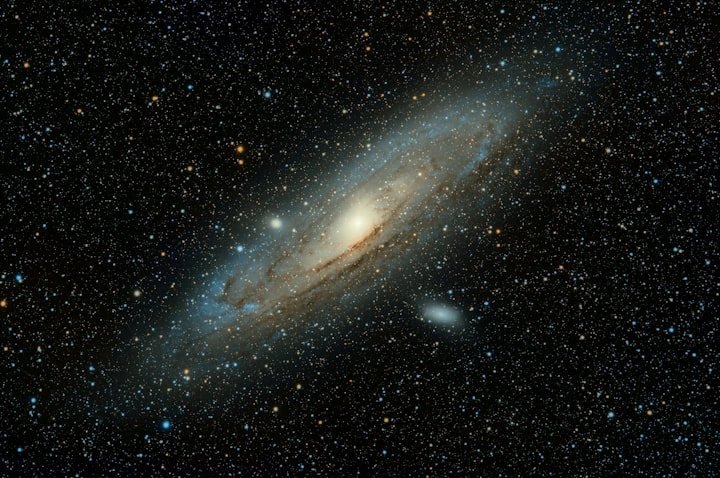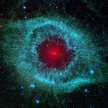Our Galaxy Is on a Collision Course
The Milky Way is on a collision course with another large galaxy.

British spelling.
I write easy-to-understand stories regarding the universe and life. Here are two of them. Enjoy.
<><><>
1/2
Our galaxy is on a collision course.
Andromeda is a spiral galaxy similar to our Milky Way but much larger. It is approximately 2.5 million light-years from our planet.
2.5 million light-years is a vast distance when you consider that light travels 9.46 trillion kilometres in one year. A trillion is 1 followed by 12 zeros.
Andromeda is the nearest large spiral galaxy to the Milky Way and is estimated to hold a trillion stars. It has a diameter of over 200,000 light-years and can be seen at night as a fuzzy patch by the naked eye.
At this time, the Andromeda galaxy is racing towards the Milky Way galaxy at roughly 110 kilometres per second, which works out to 396,000 kilometres per hour. There is no need to panic; the two galaxies will not merge until approximately four billion years.
By then, the Earth will be void of all life. Our planet, which has hosted countless organisms, will be far too hot for any form of life to survive.
It will take an extremely long time, but the two galaxies will eventually settle down and become one large elliptical galaxy.
When that merger happens, you might think that star collisions will be frequent, but star collisions will be very few due to the vast distances between them.
<><><>
2/2
Our importance in the universe.

Photo by Greg Rakozy on Unsplash
We all live on the surface of a rock that orbits a star that orbits a black hole at the centre of our galaxy.
Most of us give little thought to why we are here and where we are going. From our perspective, earth seems stationary in space, but that is far from the truth.
If you were standing on the equator, the widest part of the Earth, you'd be speeding along at 1,600 kilometres per hour. The reason for that speed is the earth spinning on its axis once every 24 hours.

Photo by NASA on Unsplash.
The Earth and the other 7 planets follow the Sun on its journey around the centre of our galaxy, the Milky Way. That orbit is called a galactic year and takes roughly 230 million years to complete.
As we travel around the centre of our galaxy, our planet is speeding along at roughly 292,000 km/h.
To top it off, our galaxy is moving through space at over 2 million km/h, and we don't even notice it.
The Milky Way, our spiral galaxy, is part of the local group of 50 or more galaxies, and on a bigger scale, the local group is part of the Virgo supercluster of galaxies.
The Milky Way is estimated to be 100,000 light-years across, one light-year is equivalent to 9.46 trillion kilometres.
One trillion is a 1 followed by 12 zeros.
It is difficult for astronomers to accurately assess how many stars there are in the Milky Way; a lower estimate would be 100 billion stars, and higher estimates can be up to 400 billion.
Many of the star systems scattered throughout our galaxy will be similar to our solar system, which consists of all the planets, dwarf planets, moons, asteroids, and all the other celestial bodies that orbit the Sun.

Image by WikiImages from Pixabay.
Our solar system is approximately 26,000 light-years from the Milky Way's centre and positioned halfway along the Orion Arm, which is 10,000 light-years long.
The total mass contained in the Milky Way galaxy is estimated to be 1.5 trillion times the mass of the Sun. If you could mix up all the mass and space in the Milky Way so that it was distributed equally, then each cubic light-year of space would contain around 40% of the Sun's mass.
It may seem like a large mass, but a one-light-year cube is a large volume.
It is difficult for astronomers to figure out what the Milky Way looks like. The shape of our galaxy has to be worked out from within.
We can see other distant galaxies with all their complex shapes and sizes but no man-made object has been outside our galaxy to take a picture, and considering the vast distances involved, I think it is safe to say that there never will be.

Photo by Benjamin Voros on Unsplash.
Lurking at the centre of our galaxy is a black hole called Sagittarius A*, with a diameter of 44 million kilometres and an estimated mass of 4 million times that of the Sun.
But having said that, the earth, sun, solar system, and even our galaxy are minuscule in comparison to that gargantuan place we call the universe.
The end.
<><><>
You may find my easy-to-understand stories about the universe and life interesting and educational.
Subscribe to me for free, and you will see my latest stories. Enjoy.
<><><>
About the Creator
A B Forbes
Someone with a lifelong passion for that gargantuan area we call the universe. I also write stories about life itself. Enjoy






Comments
There are no comments for this story
Be the first to respond and start the conversation.